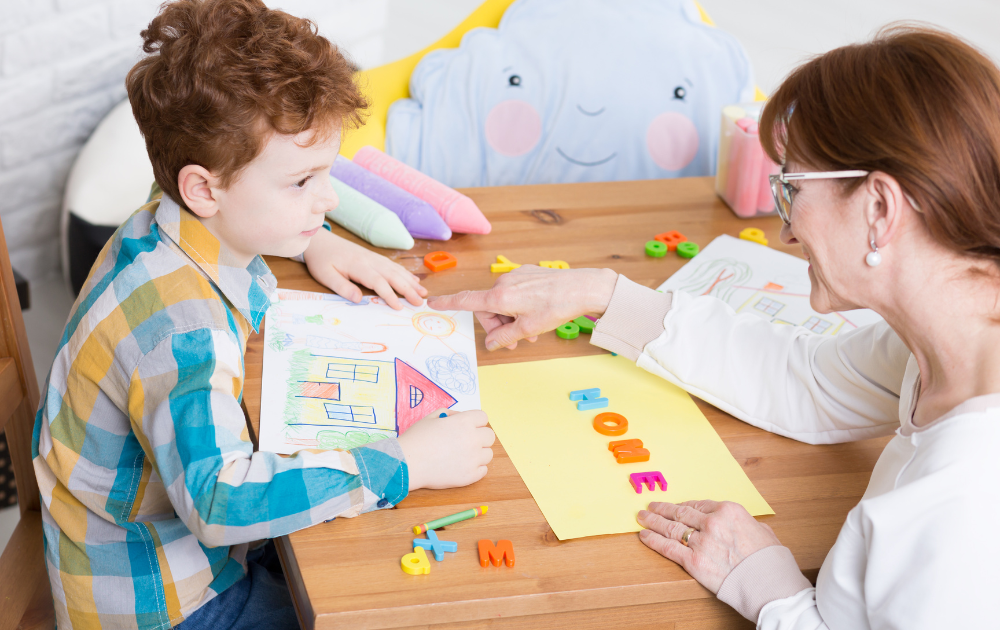
Table of Contents
ABA therapy, short for Applied Behavior Analysis therapy, is a scientifically proven intervention that aims to improve the lives of individuals with autism spectrum disorder (ASD). This therapeutic approach focuses on understanding and modifying behaviors to promote positive changes and enhance functional skills. For those who prefer a more personalized setting, autism therapy at home can be an excellent option, offering the benefits of ABA therapy in a comfortable and familiar environment.
Overview of ABA Therapy
ABA therapy is based on the principles of behavior analysis, which involve identifying and analyzing the relationship between an individual’s behavior and the environmental factors that influence it. The therapy utilizes systematic techniques to teach and reinforce desired behaviors while reducing challenging or maladaptive behaviors.
The primary goal of ABA therapy is to enhance the individual’s social, communication, and adaptive skills, enabling them to lead more independent and fulfilling lives. It is a highly individualized approach, tailored to the specific needs and strengths of each person receiving therapy.
Effectiveness of ABA Therapy
ABA therapy has garnered significant attention and recognition for its effectiveness in treating autism spectrum disorder. In fact, studies have shown that ABA therapy has an over 89% success rate in treating autism spectrum disorder in children.
A meta-analytic study conducted on applied behavior analytic (ABA) interventions concluded that they are highly effective for children with ASD. These interventions have been found to improve IQ scores, communication skills, and language skills.
Furthermore, ABA interventions are recognized as the most effective evidence-based interventions for children with ASD. The therapy focuses on breaking down complex skills into smaller, more manageable steps, allowing individuals to learn and generalize these skills across various settings and situations.
The success of ABA therapy can be attributed to its individualized and data-driven approach. By systematically monitoring and analyzing the individual’s progress, behavior analysts can make data-informed decisions to modify and refine the therapy plan as needed.
In the next sections, we will explore the success rates of ABA therapy, its benefits in improving adaptive behavior, and the factors that contribute to its effectiveness.
Success Rates of ABA Therapy
ABA therapy, also known as applied behavior analysis therapy, has shown promising success rates in treating individuals with autism spectrum disorder (ASD). Understanding these success rates can provide valuable insights for parents and caregivers seeking effective interventions for their loved ones.
Specifically, ABA programs were found to be very effective in improving intellectual abilities, moderately to very effective in improving communication skills and expressive and receptive language skills, and moderately effective in improving IQ scores provided by non-verbal tests and adaptive behavior.
It is important to note that the success rates may vary depending on individual factors, such as the severity of the individual’s condition and the duration and intensity of the therapy. However, the overall success rates highlight the potential of ABA therapy in bringing about positive changes in individuals with ASD.
Factors Influencing Success
While ABA therapy has shown promising success rates, it is important to consider the factors that can influence the outcomes. Some factors that may influence the success of ABA therapy include:
By understanding the success rates and factors that influence the effectiveness of ABA therapy, parents and caregivers can make informed decisions and develop realistic expectations. ABA therapy has been recognized as one of the most effective evidence-based interventions for individuals with ASD, offering hope and potential for meaningful improvements in their lives.
Benefits of ABA Therapy
ABA therapy, also known as applied behavior analysis therapy, has been proven to be highly effective in treating autism spectrum disorder (ASD) in children. This section will explore the specific benefits of ABA therapy, including improvement in IQ scores, enhancing communication skills, and its impact on adaptive behavior.
Improvement in IQ Scores
A meta-analytic study has demonstrated that ABA interventions have a significant positive impact on IQ scores for children with ASD. These interventions have been found to be moderately effective in improving IQ scores provided by non-verbal tests. This improvement in intellectual abilities can lead to enhanced cognitive functioning and overall development.
Enhancing Communication Skills
ABA therapy plays a crucial role in helping individuals with autism develop and enhance their communication skills. Communication deficits are a common challenge for individuals with ASD, and ABA interventions have been shown to be highly effective in improving expressive and receptive language skills. By focusing on specific behavioral strategies, ABA therapy helps individuals with autism develop effective communication techniques, such as verbal and non-verbal communication, social interactions, and understanding social cues.
Impact on Adaptive Behavior
Adaptive behavior refers to the skills necessary for daily functioning and independence. ABA therapy has been recognized as the most effective evidence-based intervention for improving adaptive behaviors in children with ASD. These interventions have shown to be very effective in improving adaptive behavior gains and moderately effective in improving adaptive behavior progress. Even the lowest functioning children have experienced clinically significant adaptive behavior gains after 24 months of ABA therapy.
To summarize, ABA therapy offers numerous benefits for individuals with autism spectrum disorder. It has been shown to improve IQ scores, enhance communication skills, and have a positive impact on adaptive behaviors. By utilizing evidence-based interventions and tailored approaches, ABA therapy helps individuals with autism reach their full potential, fostering meaningful improvements in their overall development and quality of life.
Duration and Continuation of ABA Therapy
When considering ABA therapy for individuals with autism, it’s important to understand the duration of therapy and the factors that can influence its continuation. ABA therapy is a comprehensive and individualized approach that requires consistent effort and commitment from both the therapist and the individual receiving therapy.
Duration of ABA Therapy
The duration of ABA therapy can vary depending on the specific needs and progress of each individual. Research has shown that, on average, 66% of children referred for ABA therapy initiate therapy and remain in services for 12 months. However, less than half (46%) continue therapy for 24 months.
It’s important to note that the duration of therapy is not a one-size-fits-all approach. The length of therapy may be influenced by factors such as the severity of the individual’s autism, the specific goals and objectives of therapy, and the availability of resources and support.
Factors Affecting Continuation
Several factors can influence the continuation of ABA therapy. One such factor is the individual’s history of special education. Research suggests that individuals with a history of special education tend to spend a longer time in ABA therapy. This may be due to the additional support and structure provided by special education programs, which can complement the goals of ABA therapy.
Another factor that can impact the continuation of ABA therapy is the family’s socioeconomic status and support system. Studies have shown that having a single parent is associated with discontinuation of ABA therapy. This may be due to the increased demands and challenges faced by single parents in accessing and maintaining therapy services.
It’s important for parents and caregivers to consider these factors and work closely with the ABA therapy provider to ensure the best possible outcomes for their child. Open communication, collaboration, and ongoing assessment of progress are key to making informed decisions about the continuation of therapy.
Adaptive Behavior Gains
When it comes to the success of ABA therapy, one important aspect to consider is the impact it has on adaptive behavior. Adaptive behavior refers to a person’s ability to effectively navigate and respond to the demands of everyday life. In this section, we will explore the progress made in adaptive behavior through ABA therapy and its specific impact on low-functioning children.
Adaptive Behavior Progress
ABA therapy has shown promising results in improving adaptive behavior in individuals with autism. Research indicates that ABA programs are very effective in enhancing intellectual abilities and moderately to very effective in improving communication skills, expressive and receptive language skills, and adaptive behavior.
Through a combination of behavioral interventions, ABA therapy aims to teach individuals with autism the skills necessary to function more independently in various settings. These interventions are tailored to the individual’s specific needs and focus on areas such as social skills, daily living activities, and self-care.
By targeting adaptive behavior, ABA therapy aims to help individuals with autism develop the skills required to effectively interact with others, manage daily tasks, and adapt to different situations. This progress in adaptive behavior can have a profound impact on overall quality of life and independence.
Achieving Meaningful Improvements
In ABA therapy, achieving meaningful improvements is a primary goal for individuals with autism. Through clinical improvement criteria and tailoring ABA therapy to individuals, significant progress can be made in various areas of development.
Clinical Improvement Criteria
ABA therapy focuses on measurable and observable behavior changes, which allows for the assessment of clinical improvement. The clinical improvement criteria for ABA therapy are often based on specific behavioral goals and objectives that are tailored to the individual’s needs.
These goals may include improving social skills, reducing challenging behaviors, enhancing communication abilities, and increasing adaptive behavior. The success of ABA therapy is often determined by the extent to which these goals are achieved.
ABA therapists utilize various assessment tools to measure progress, such as direct observation, data collection, and standardized assessments. By closely monitoring and analyzing the individual’s behavior, therapists can track improvements over time and adjust the treatment plan accordingly.
Tailoring ABA Therapy to Individuals
One of the strengths of ABA therapy is its ability to be tailored to the unique needs of each individual. ABA programs are highly individualized, taking into account the specific strengths, challenges, and goals of the person receiving therapy.
By conducting thorough assessments and gathering detailed information about the individual’s abilities and preferences, ABA therapists can choose or design interventions that are most effective for that particular individual. This personalized approach allows for targeted interventions that address specific areas of need and promote meaningful improvements.
ABA therapy sessions are structured and typically involve one-on-one interactions between the therapist and the individual. The therapist utilizes evidence-based techniques to teach and reinforce desired behaviors and reduce challenging behaviors.
Throughout the course of therapy, the treatment plan is continuously evaluated and modified based on the individual’s progress. This flexibility ensures that the therapy remains effective and relevant as the individual grows and develops.
By tailoring ABA therapy to the unique characteristics and needs of each individual, therapists can maximize the potential for meaningful improvements in areas such as communication, social skills, adaptive behavior, and overall quality of life.
Sources:
https://www.ncbi.nlm.nih.gov/pmc/articles/PMC8702444/
https://www.sciencedirect.com/science/article/abs/pii/S1750946718300485
- Signs of an Autistic Child at Age Two - April 11, 2024
- Can Trauma Cause Autism? - April 11, 2024
- Can an Autistic Child Go to Normal School? - April 11, 2024





